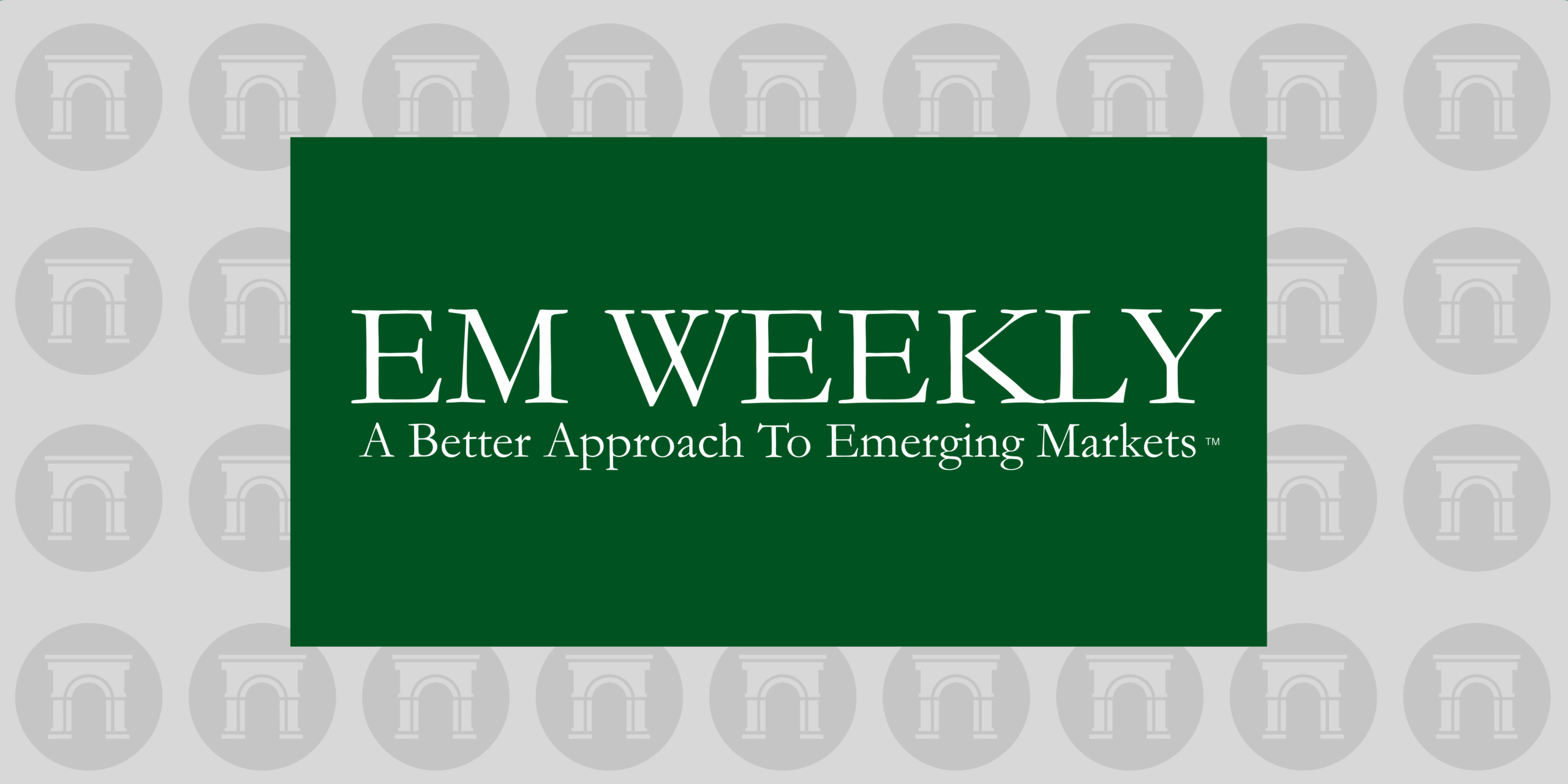Contents
Market Overview
Macro Update
On Friday, Fed Chair Jerome Powell’s highly anticipated speech opened the door wider to a rate cut next month. His remarks validated an already elevated market probability for a cut, which climbed to nearly 90% following the speech. At the Jackson Hole, Wyoming economic symposium, Chair Powell spoke about potentially “adjusting the Fed’s policy stance,” shifting focus to the cooling labor market. His dovish tone sent markets surging across the board; U.S. equities gained around 2% on the day, posting a weekly gain. The exception was the tech-heavy NASDAQ index, which was weighed down by concerns earlier in the week that high valuations of AI firms could be overdone.
U.S. Treasury yields declined, and the curve steepened as the 30-year yield was 5bps lower on Friday, at around 4.89%, while the 2-year yield dropped 11bps to 3.68%. Oil markets were little changed with WTI and Brent remaining in the mid-60s per barrel. The dollar moved markedly weaker amid Chair Powell’s apparent dovish pivot, to below 98 on the DXY and back above 1.17 on EURUSD.
Meanwhile, President Donald Trump announced his intentions to fire Federal Reserve board member Lisa Cook, who was appointed by former President Joe Biden, over allegations of mortgage fraud. Mr. Trump’s attacks against Ms. Cook were the latest in the White House’s pressure campaign on the Fed to lower interest rates.
In addition to U.S. monetary policy, markets focused this week on geopolitics amid President Trump’s shuttle diplomacy on the war in Ukraine. After meeting Russian President Vladimir Putin in Alaska, Mr. Trump hosted President Volodymyr Zelenskiy and Europe’s top political leaders at the White House a few days later. They agreed to work on outlining “security guarantees” as a pre-condition for potential peace with Russia. President Trump appeared to suggest that his administration could consider providing a U.S. backstop to a possible European reassurance force. Both Mr. Trump and Mr. Zelenskiy called for a face-to-face meeting with President Putin.
But the Kremlin quickly poured cold water the ideas. Sergei Lavrov, Russia’s foreign minister, signaled that Moscow will only agree to security guarantees for Ukraine that give Russia a veto over any activation of those guarantees, essentially invalidating the idea.
On the macro data front, U.S. initial jobless claims increased by 11,000 to 235,000 in the week ended August 16th, adding to signs of a cooling labor market. However, preliminary August PMIs surprised to the upside across the board, especially in terms of manufacturing (53.3 vs. 49.8 in July and 49.7 consensus). In corporate earnings, major U.S. retailers such as Walmart and Home Depot reported 2Q results with mixed signals on the economy. Walmart sales rose nearly 5% as more consumers hunted for better pricing amid inflation and general economic uncertainty concerns. Home Depot, the largest U.S. home improvement retailer, warned of “modest” price increases due to trade tariffs.
In the UK, July inflation was reported at 3.8% year-on-year, above consensus expectations, driven mainly by higher transport costs. Services inflation, closely watched by the Bank of England, also came in higher than expected, at 5.0% vs. 4.8% year-on-year, lowering the probability of an imminent rate cut.
Preliminary August PMIs across Europe surprised generally on the upside vs. consensus expectations. A few economies, though, remain in contractionary territory. At the eurozone level, PMIs were also upbeat; however, the preliminary August consumer confidence index declined further to -15.5, the lowest level since April, from -14.7 in July, which could have implications for the ECB’s September rate meeting.
In Asia, Japan’s July CPI data showed inflation softening from June (down to 3.1% year-over-year from 3.3%), but remains well above the BoJ’s target, signaling a rate hike might be on the table. Japan’s manufacturing PMI improved, while services declined but remained in expansionary territory. Meanwhile, China kept 1-year (3.0%) and 5-year (3.5%) loan prime rates unchanged, as expected. Indonesia’s central bank surprised markets with a second consecutive 25bps rate cut to 5.00% and provided dovish forward guidance. In Latin America, the first round of presidential elections in Bolivia ended more than two decades of leftist rule by the MAS party, with centrist Senator Rodrigo Paz and conservative former President Jorge “Tuto” Quiroga progressing to a runoff in mid-October.
EM Credit Update
EM Hard Currency Sovereign Debt turned negative through Thursday, returning -0.23%, as positive risk sentiment paused during a typically quiet summer week. However, performance improved on Friday following Mr. Powell’s speech at Jackson Hole, though this report reflects data only through Thursday. Within the weekly returns to Thursday, high-yield debt underperformed, posting losses of 0.30% vs. 0.16% for investment grade. Spreads widened modestly by 5bps overall, with high yield widening by 8bps and investment grade by 3bps, indicating still-muted market moves.
Africa led regional underperformance, reflecting its higher beta profile and broad weakness across the continent. Ukraine was the week’s worst performer, driven by renewed skepticism of a near-term peace settlement. Argentina also lagged, amid ongoing foreign exchange pressures and political tension between the president and the senate. By contrast, Bolivia defied the broader trend, rallying sharply after a surprise election result ended two decades of leftist rule. The emergence of centrist candidate Paz and right-wing former President Quiroga as frontrunners has set the stage for Bolivia’s first-ever presidential runoff, scheduled for October 19.
EM Local Currency Debt also posted negative returns through Thursday, down 0.52%. Brazil, Indonesia, and South Africa were the primary underperformers, giving back gains from the prior week. Only Uruguay, Colombia, and Türkiye managed positive returns in local currency terms through Thursday. However, emerging markets local debt got a boost across the board at the end of the week as dovish comments by Chair Powell drove the dollar lower, supporting emerging market currencies.
EM Corporate Bonds proved more resilient, with largely flat performance through Thursday. Investment-grade corporates with maturities over 10 years delivered slightly positive returns, while spreads remained stable. As expected, Asia, being more rate-sensitive, outperformed other regions.
Primary market activity remained subdued, in line with seasonal trends. Only three hard currency corporate deals were priced: two from Asia and one from Latin America. There was no sovereign issuance, consistent with the typical August slowdown.
The Week Ahead
In the aftermath of the Jackson Hole summit and amid strong consensus expectations for a September rate cut, markets next week will anticipate the Federal Reserve’s preferred inflation measure, the PCE price index for July, as well as other important U.S. macro data such as personal income/spending, University of Michigan consumer sentiment, wholesale inventories, 2Q GDP second reading, and initial jobless claims, among others. Also, the U.S. is expected to impose a 50% tariff on imports from India and end its “de minimis” tariff exemption, which allowed low-value imports to enter the U.S. duty-free.
Meanwhile, 2Q GDP figures and updates are due from multiple countries including France, India, Nigeria the Czech Republic, as are inflation figures from Brazil, France, Germany, Poland and Sri Lanka. Rate decisions will be delivered by central banks in Hungary, Egypt, and the Philippines. Additionally, Germany IFO business climate and eurozone consumer confidence data will be reported, as will earnings by Nvidia. South Korean President Lee Jae Myung is scheduled to meet President Trump at the White House, and Thailand’s constitutional court will deliver a verdict on the ethics case involving suspended Prime Minister Paetongtarn Shinawatra.
Fixed Income
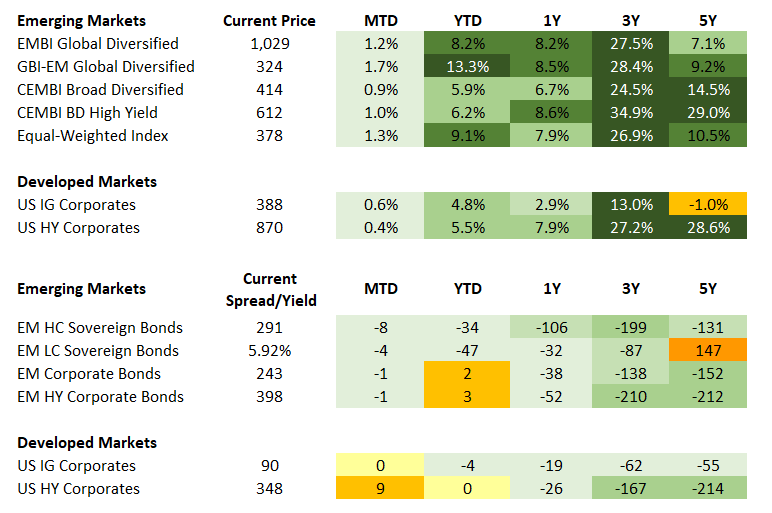
Equities

Commodities

Source for data tables: Bloomberg, JPMorgan, Gramercy. EM Fixed Income is represented by the following JPMorgan Indicies: EMBI Global, GBI-EM Global Diversified, CEMBI Broad Diversified and CEMBI Broad High Yield. DM Fixed Income is represented by the JPMorgan JULI Total Return Index and Domestic High Yield Index. Fixed Income, Equity and Commodity data is as of August 22, 2025 (mid-day).
Highlights
Peace in Ukraine Remains Elusive Despite Recent Summits
Event: Last week, President Trump engaged in a diplomatic blitz with key stakeholders in the Ukraine-Russia conflict, meeting first with the Russian leader in Alaska and a couple of days later hosting Ukraine’s president Zelenskiy and Europe’s top political leaders at the White House.
Gramercy Comment: The Alaska meeting was the first by a Western leader with President Putin since the start of Russia’s full-scale invasion of Ukraine in February 2022, potentially marking a new chapter in efforts to find a negotiated end to the conflict. However, while both sides have clear incentives to engage in Trump-mediated negotiations and demonstrate willingness to achieve peace, their ability to do so remains constrained by diametrically opposed objectives and a general stalemate on the battlefield. Ukraine is looking for long-term security guarantees in the form of “NATO Article 5-like” commitments by the U.S. and Europe and hundreds of billions in new weaponry. Russia’s demands appear to include the annexation of territories not even currently under the control of the Kremlin’s forces in Eastern Ukraine.
Both countries are likely to retain unacceptable “red lines” from the other side’s perspective. Comments by the Kremlin already appear to completely invalidate the idea of a Western security guarantee for Ukraine, with Russia demanding veto power over any guarantees. And getting Mr. Putin to agree to meet Mr. Zelenskiy for face-to-face peace talks seems highly unlikely to us. In that context, we remain skeptical that a mutually acceptable negotiated solution is in the cards for Ukraine.
However, the concept of achieving peace has been reinvigorated by last week’s developments. We acknowledge that markets could remain in a “hopeful” mode as long as high-profile political negotiations are ongoing, pricing in some probability of a potential “constructive scenario,” – even though we continue to see this scenario as unlikely.
Bolivia’s Politics Shift Right After Decades of Leftist Rule
Event: Centrist Senator Paz came out on top in the first-round of Bolivia’s presidential election, with 32%, and will face conservative former President Quiroga (27%) in a runoff in mid-October. In terms of congressional seats, conservative and centrist opposition forces managed to secure large shares of both the senate and the lower house.
Gramercy Comment: These results mark a potentially credit-positive structural shift away from the leftist Movimiento al Socialismo party’s (MAS) economic policies of the last two decades. MAS’s political sidelining comes amid widespread voter dissatisfaction with macroeconomic deterioration, fuel shortages and dwindling foreign exchange reserves, among other pressing concerns. In that context, Bolivia’s economic imbalances are extensive and will require significant political willingness and ability to adjust. Potential engagement with the IMF would help and would be welcomed by the market, but it remains unclear whether the new administration will be open to exploring a potential Fund program, despite limited financing options.
If the incoming president chooses to pursue significant structural reforms, the composition of the new congress bodes well for coalition building with other center-right political parties. However, former president Evo Morales, who was blocked from participating in the elections and has now created a new party (EVO Pueblo), could try to channel his supporters’ frustration into organizing street protests against market-friendly policy changes – a risk that investors should be watching closely in coming weeks.
Bolivia’s sovereign bonds have rallied in anticipation of a constructive election outcome. In a scenario of an improving economic policy outlook, the country’s natural resources and limited market debt could be supportive for a further recovery in bond prices.
Emerging Markets Technicals
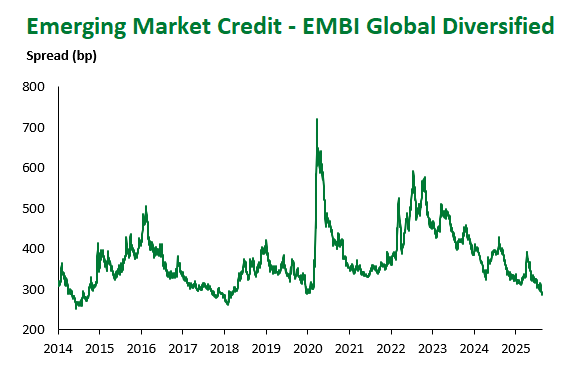
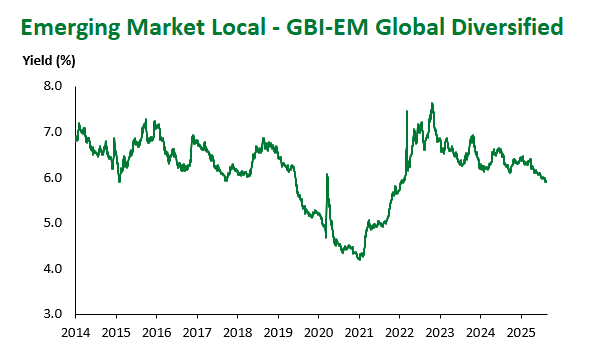
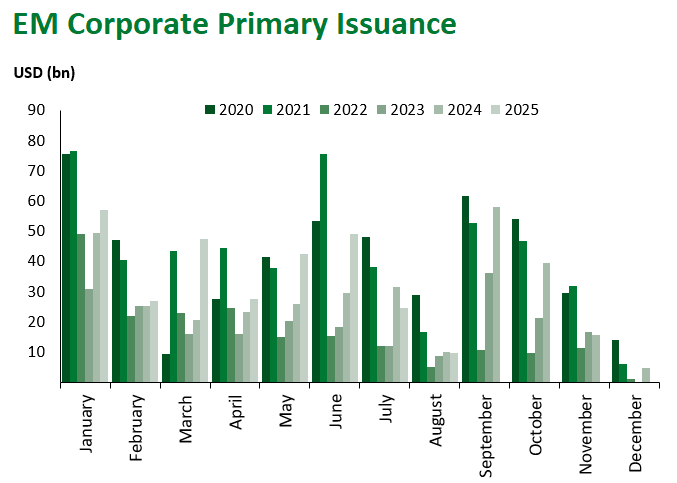
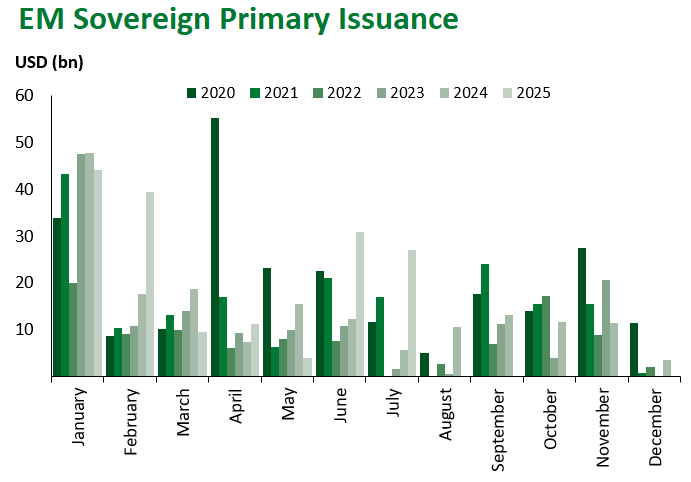
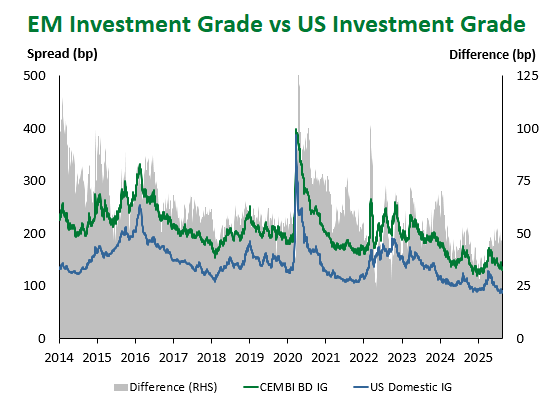

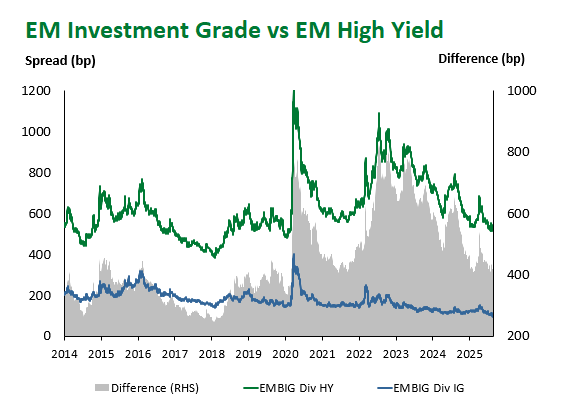
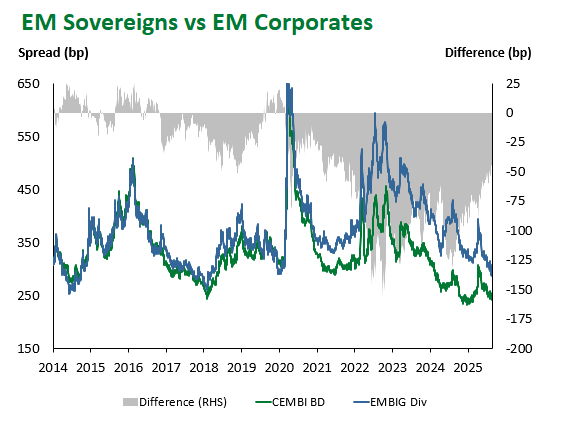
Emerging Markets Flows
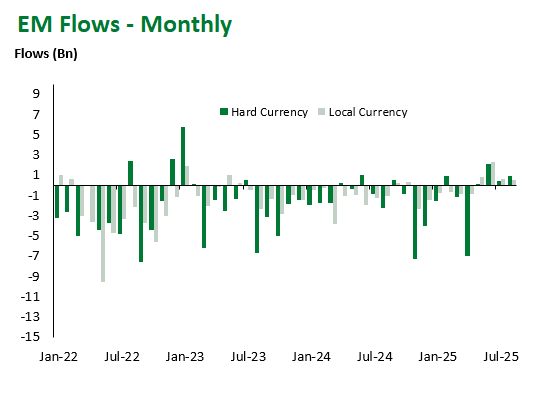
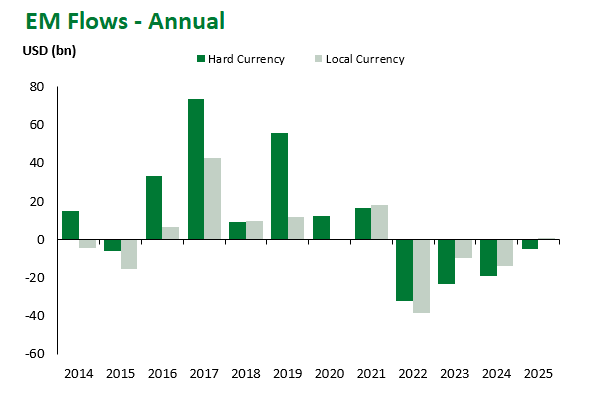
Source for graphs: Bloomberg, JPMorgan, Gramercy. As of August 22, 2025.
For questions, please contact:
Kathryn Exum, CFA ESG, Director, Co-Head of Sovereign Research, [email protected]
Petar Atanasov, Director, Co-Head of Sovereign Research, [email protected]
This document is for informational purposes only. The information presented is not intended to be relied upon as a forecast, research or investment advice, and is not a recommendation, offer or solicitation to buy or sell any securities or to adopt any investment strategy. Gramercy may have current investment positions in the securities or sovereigns mentioned above. The information and opinions contained in this paper are as of the date of initial publication, derived from proprietary and nonproprietary sources deemed by Gramercy to be reliable, are not necessarily all-inclusive and are not guaranteed as to accuracy. This paper may contain “forward-looking” information that is not purely historical in nature. Such information may include, among other things, projections and forecasts. There is no guarantee that any forecasts made will come to pass. Reliance upon information in this paper is at the sole discretion of the reader. You should not rely on this presentation as the basis upon which to make an investment decision. Investment involves risk. There can be no assurance that investment objectives will be achieved. Investors must be prepared to bear the risk of a total loss of their investment. These risks are often heightened for investments in emerging/developing markets or smaller capital markets. International investing involves risks, including risks related to foreign currency, limited liquidity, less government regulation, and the possibility of substantial volatility due to adverse political, economic or other developments. References to any indices are for informational and general comparative purposes only. The performance data of various indices mentioned in this update are updated and released on a periodic basis before finalization. The performance data of various indices presented herein was current as of the date of the presentation. Please refer to data returns of the separate indices if you desire additional or updated information. Indices are unmanaged, and their performance results do not reflect the impact of fees, expenses, or taxes that may be incurred through an investment with Gramercy. Returns for indices assume dividend reinvestment. An investment cannot be made directly in an index. Accordingly, comparing results shown to those of such indices may be of limited use. The information provided herein is neither tax nor legal advice. Investors should speak to their tax professional for specific information regarding their tax situation.
